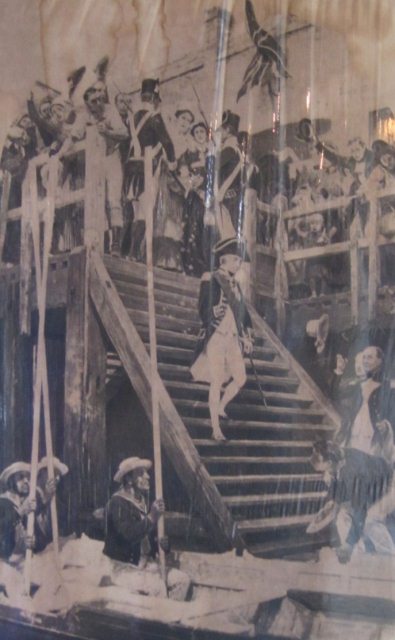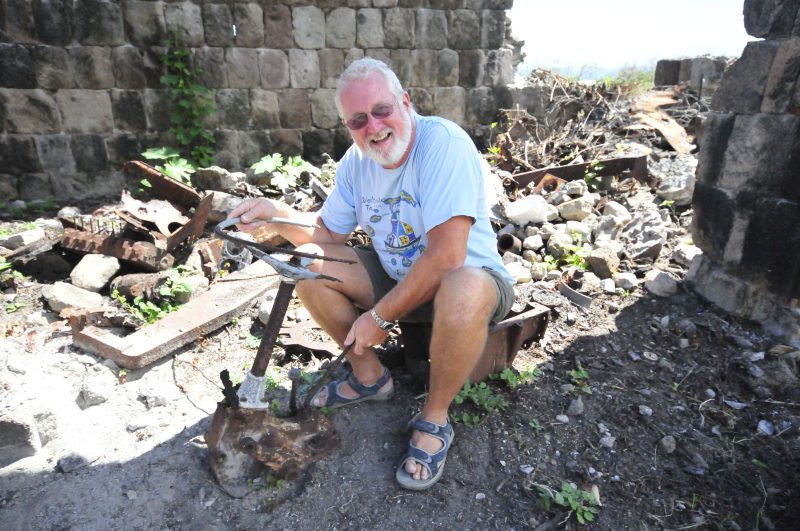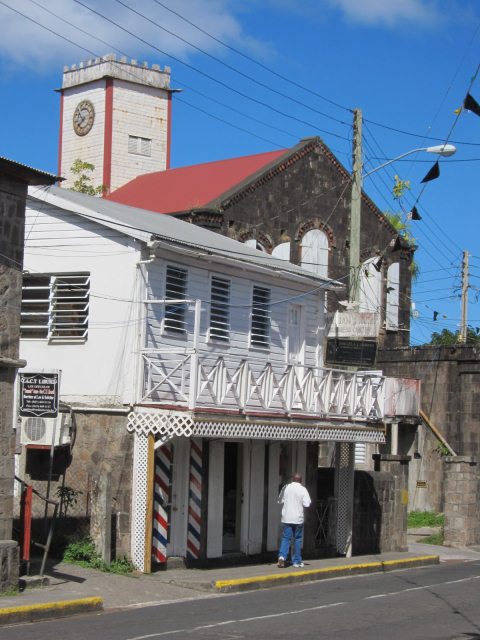|
Nevis

Shian
We went to say good morning to Shian, this is her first photograph since seeing
her off from Puerto Rico last year. Then off we went to explore. Nevis'
pre-Columbian name was "Oualie", which translates to "land of beautiful waters",
presumably referred to the island's many freshwater springs and hot volcanic
springs. The island is thirty six square miles and looks a bit like a sombrero
from the sea. The population is around nine thousand. Rainfall is about forty
eight inches per year with a temperature range of seventeen to thirty three
degrees centigrade.
Charlestown,
the only town, is picturesque with many stone (skirt) and wooden (blouse)
buildings.
Landing of Virginia
settlers
This
is on the wall outside the building Alexander Hamilton was born - the plaque
says: At Nevis there landed on 25 March, 1607, for a stay of six days, a company
of 144 Englishman bound for Virginia. On 13 May 1607, that same group founded at
Jamestown, Virginia. The first permanent English settlement beyond the British
Isles, from that colony grew the overseas expansion of the English speaking
peoples: The Commonwealth of Virginia: the United States of America: and the
british Commonwealth of Nations and Realms overseas.

Bath Hotel and Bath
House circa 1778. This hotel is reputed to be the oldest in the
Caribbean. At the height of its popularity the hotel was surrounded by
landscaped grounds called "The Gardens of Jericho". In 1787, a reception to
celebrate the marriage of Captain Horatio Nelson to Nevisian born widow Frances
"Fanny" Nisbet nee Woolward was held. The ball along with a sit
down dinner for 100 people, included Prince William Henry, Duke of
Clarence, later King William IV of England. In the mid 19th Century a nine hole
golf course was built on the grounds - the first in the Caribbean and one
of the first in the western hemisphere. The hotel stayed open for nearly a
century, closed, then reopened to house troops of the British West India
Regiment in World War I. It was reopened in the 1920's and during World War II
again to house troops. It was abandoned after the war, but used from time to
time by persons who tried to reopen it. From 1996 to 1999, it was refurbished
and used to house the Police Department and Magistrates Court. Today it is used
by the Premiers' Ministry.
Christopher Columbus , upon sighting what we now call Nevis in
1498, gave that island the name Saint Martin. However, the confusion of
numerous, poorly charted small islands in the Leeward Island chain, meant that
the name ended up being accidentally transferred to another island, the one
which we now know as the French/Dutch island Saint Martin. The current name "Nevis" is derived from a
Spanish name Nuestra Senora de las Nieves. This Spanish name means Our Lady of the
Snows. It is not known who chose this name for the
island, but it is a reference to the story of a 4th century Catholic miracle: a
snowfall on the Esquiline Hill in Rome. Presumably the white clouds which
usually wreathe the top of Nevis Peak reminded someone of the story of a
miraculous snowfall in a hot climate. The island of Nevis, upon first British
settlement was referred to as "Dulcina", a name meaning "sweet one". Its
original Spanish name, "Nuestra Señora de las Nieves", was eventually kept
however, though it was soon shortened to "Nevis".
The island of Nevis was colonised in
1628 by British settlers from Saint Kitts. From there, Saint Kitts became the
premier base for British and French expansion, as the islands of
Antigua. Montserrat, Anguillar and
Tortola for the British and
Martinique, the Guadeloupe archipelago and St Barts for the French were colonised from it. The first
town, called Jamestown, was built near Fort Ashby, but it sank into the sea
after an earthquake and tidal wave in 1680. By 1706 Nevis was home to 8600
slaves. In the years from 1721 to 1726, 1267 slaves were imported at an average
of 253 per year. Various battles between the French and English hampered
development until 1783, when Nevis became English for an extended time. By
1774 the population of Nevis was 1,00 whites and 10,000 slaves. It flourished as
a plantocracy and there are many old plantations and sugar mills on the island.
The old mills are crumbling, but the plantations have been converted into high
end hotels (own blog).

 
 
The small museum a few miles out of town is dominated by
Nelson and Victory memorabilia, including a chair from HMS Victory and one of
Nelson's uniforms
 
This picture of Nelson was taken of Nelson dated
the 14th of September 1805, is protected with cling
film. An interesting cross section of HMS Victory. Commissioned in
1778, she was the largest English warship. Supported by 110 cannons and 850 men
and officers, the Victory cut a striking vision on the open seas stretching 126
in length with a mast rising 205 feet from the water. After the Battle of
Trafalgar, Nelson's body was transported back to England on the Victory. Due to
his rank, he was not buried at sea as most others killed in action on the seas.
Instead, Nelson's body was sealed in a cask of brandy which acted as a
preservative until it could be properly attended to. On the 5th of December
1805 the Victory returned to England and docked at Spithead.
This piece of cloth is a tiny piece of the Union Jack under
which Nelson was standing when he received his fatal wound at Trafalgar. The
flag was also carried at his funeral in London on the 9th of January 1806, an
invitation is proudly hanging in the museum, along with a copy of the painting
of the funeral barges on the River Thames. Another
display shows the tenth Anniversary of Independence.
The Methodist Church,
Gingerland
 
Cute houses, the one on the right is Elliots
Funeral Home. I'm delighted to see a Mack Truck

Hurricane Omar damaged these buildings

.
New River Coconut Walk - a sugar processing plant - just
walked away from

A hot contender for the 'One Careful Owner'

Or this one
Alexander Hamilton's
birthplace is now a small museum.
Two historical figures are associated with
Nevis - Alexander Hamilton , the first United States Secretary of
the Treasury, was born in Nevis; he spent his childhood there and on St.
Croix (then belonging to Denmark)
-now one of the USVI's. The more famous - Horatio Nelson married
Nevisian widow Frances "Fanny" Nisbet nee Woolward in 1787. At this
time there were 8,000 slaves to 1,300 whites, from this time the slave operation
began to decline.
Mount Nevis is the highest point at 3232
feet

The View of St Kitts stunning
ALL IN ALL COULD BE QUAINT BUT TOO MANY HIGH END
HOTELS
A LITTLE TOO
COMMERCIAL
.
|

























